The Lifesaving Society Swim for Life® program is a comprehensive swim lesson program that focuses on the development of fundamental swim strokes and skills for learners of all ages and abilities. Instructors ensure swimmers get lots of in-water practice in every lesson. Swim for Life includes fun, hands on activities that focus on teaching Water Smart education for the whole family. Lessons that will last a lifetime!
Please note that not all levels are offered in every swim lesson season. Please visit playinpa.ca/programs/ to learn what is currently being offered, or view our current eLeisure Guide.
Parent & Tot Program Overview
Recommended age: 4 months to 3 years old. The Lifesaving Society Parent & Tot lessons structure in-water interaction between parent and child to stress the importance of play in developing water-positive attitudes and skills. Activities and progressions are based on child development allowing parents to register in the level appropriate for their child’s age: 4-12 months, 12-24 months, or 2-3 years.
 | Parent & Tot 1 – Jellyfish
Recommended age: 4-12 months. Parent & Tot 1 provides an orientation to water for infants and their parent/caregiver. Parents/caregivers will learn how to swim safely with their infant in the pool through instruction of holds and supports. Infants will be introduced to getting their face wet, blowing bubbles and floating with the help of their caregiver. |
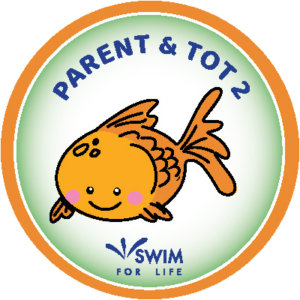 | Parent & Tot 2 – Goldfish
Recommended age: 12-24 months. Parent & Tot 2 teaches toddlers how to play in the water safely! They’ll learn how to enter and exit the water with help from their parent/caregiver and will play games to encourage them to get their face wet and blow bubbles in the water. Toddlers will also develop floating and kicking skills with the support of their parent/caregiver. |
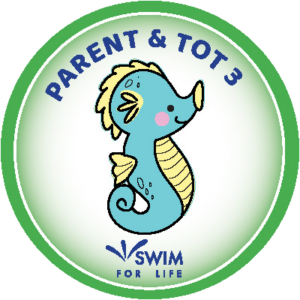 | Parent & Tot 3 – Seahorse
Recommended age: 2-3 years. Parent & Tot 3 teaches toddlers how to safely enter the water wearing a PFD. They’ll develop underwater skills such as submersion and opening their eyes underwater. ‘Starfish’ floats, ‘pencil’ floats and kicking skills are taught using songs and games. |
Preschool Program Overview
Recommended age: 3 to 5 years. Give your child a head start on learning to swim! The Lifesaving Society Preschool lessons develop an appreciation and healthy respect for the water before they get in too deep. With a progression-based approach, instructors work to ensure 3-5 year olds become comfortable in the water and have fun while developing a foundation of water skills. Water Smart education is included in all Preschool levels. Preschoolers enter Swimmer 1 once they turn five or six years old and can enter Swimmer 2 once they’ve completed Preschool 5.
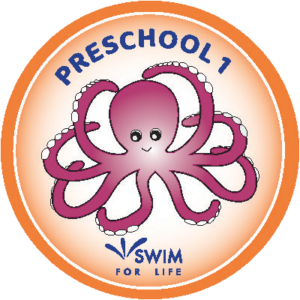 | Preschool 1 – Octopus
Recommended age: 3-5 years. Preschool 1 is a transitional level which transfers the preschooler to the care of the instructor. Preschoolers will have fun learning to get in and out of the water. They’ll learn how to put their face in the water, blow bubbles in the water, and how to float and glide. |
 | Preschool 2 – Crab
Recommended: Completed Preschool 1. Preschool 2 teaches preschoolers how to safely jump into chest-deep water and how to swim wearing a PFD. They’ll learn submersion skills and continue to work on floats, glides, and kicking with buoyant objects. |
 | Preschool 3 – Orca
Recommended: Completed Preschool 2. Preschool 3 teaches preschoolers how to enter deep water safely wearing a PFD. They’ll learn how to submerge and exhale underwater, retrieve objects underwater, and will continue developing their floating, gliding and kicking skills. |
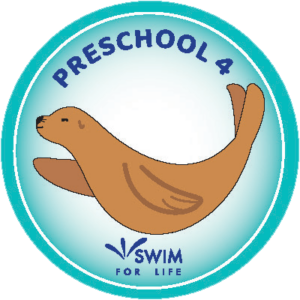 | Preschool 4 – Sea Lion
Recommended: Completed Preschool 3. Preschool 4 teaches deep-water entries and treading water wearing a PFD. Preschoolers will become skilled at retrieving objects from the bottom of the pool in chest-deep water and performing front and side glide. Front crawl wearing a PFD is also introduced. |
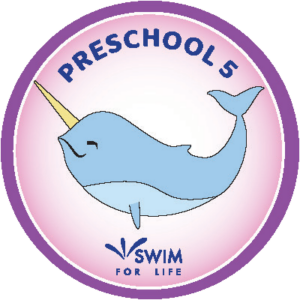 | Preschool 5 – Narwhal
Recommended: Completed Preschool 4. Preschool 5 teaches Swim to Survive® skills wearing a PFD. Front crawl and back crawl are introduced as well as interval fitness training. Preschoolers will also learn how to tread water and perform vertical whip kick with a buoyant aid. Once complete, preschoolers can register into Swimmer 2. |
Swimmer Program Overview
Recommended age: 5 to 12 years. The Lifesaving Society’s Swimmer program makes sure your children learn how to swim before they get in too deep. Each level challenges school-aged children to develop safe entries, deep water support, underwater skills, and swimming strokes. Kids learn healthy habits by getting and staying fit in the water. Swimmer levels include fun, hands-on activities that focus on teaching water safety – lessons that will last a lifetime!
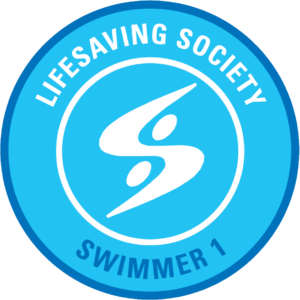 | Swimmer 1
Recommended age: 5-12 years. These beginners will become comfortable jumping into the water with and without a PFD. They’ll learn how to open their eyes, exhale and hold their breath underwater. Floats, glides and kicking skills are introduced. |
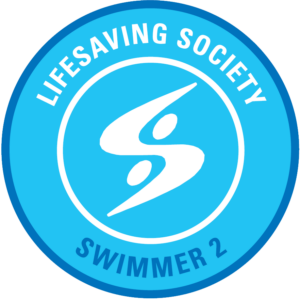 | Swimmer 2
Recommended: Completed Swimmer 1 or Preschool 5. These swimmers will jump into deeper water and learn to be comfortable falling sideways into the water wearing a PFD. They’ll learn how to tread water, develop kicking skills, and will be introduced to front crawl and back crawl. |
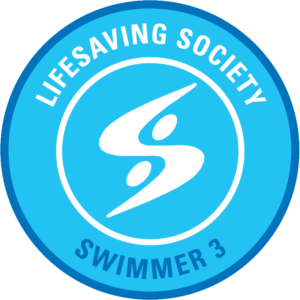 | Swimmer 3
Recommended: Completed Swimmer 2. These swimmers will learn how to dive and will do in-water somersaults and handstands to develop weight-transfer skills. They’ll learn Swim to Survive® skills, whip kick on back and will further develop their front crawl and back crawl. |
 | Swimmer 4
Recommended: Completed Swimmer 3. These swimmers will become better at diving, treading water, and swimming underwater. They’ll learn the Swim to Survive® standard and start to develop breaststroke. Front crawl and back crawl are further developed. |
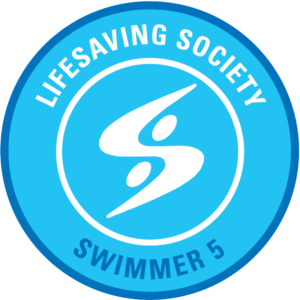 | Swimmer 5
Recommended: Completed Swimmer 4. These swimmers will master dives and swimming in deep water. They’ll further their Swim to Survive® skills and start to develop eggbeater kick. Breaststroke, front crawl, and back crawl are further developed. Interval training and sprinting drills continue to challenge these swimmers. |
 | Swimmer 6
Recommended: Completed Swimmer 5. These swimmers will become proficient at deep water skills including stride entries and compact jumps. They’ll develop lifesaving kicks such as eggbeater and scissor kick. Breaststroke, front crawl, and back crawl are further developed. Head-up swims, interval training and a 300m workout develop strength and endurance. |
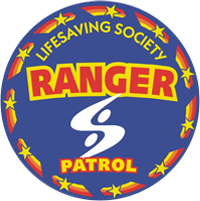 | Swimmer 7 – Rookie Patrol
Recommended: Completed Swimmer 6. Swimmers continue developing front crawl, back crawl and breaststroke. Swimmers develop individual fitness to meet a timed 100m swim and 350m workout. Water proficiency skills include swimming with clothes, ready position, and feet-first/head-first surface dives. Demonstrating the ability to conduct a primary assessment and calling EMS are included as first aid skills. Victim recognition and throwing assists are other key elements of the program. |
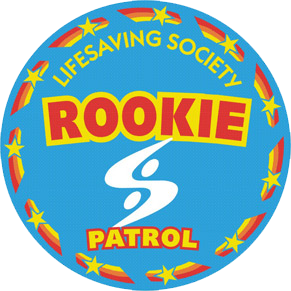 | Swimmer 8 – Ranger Patrol
Recommended: Completed Swimmer 7 – Rookie Patrol. Ranger Patrol enhances capability in the water including stride entries and underwater, forward and backward somersaults. Swimmers learn lifesaving sport skills with a lifesaving stroke medley, timed object support and a non-contact rescue with a buoyant aid. Eggbeater kick and increased fitness levels are developed to meet a 200m timed swim. First aid focuses on unconscious victims and obstructed airway procedures. |
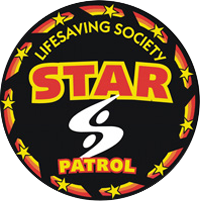 | Swimmer 9 – Star Patrol
Recommended: Completed Swimmer 8 – Ranger Patrol. Star Patrol challenges swimmers with a 300m timed swim, 600m workout and a 25m object carry. Strokes are continued to be refined. Lifesaving skills include use of rescue aids, defense methods, victim removals and supporting a victim in shallow water. First aid focuses on treatment of bone or joint injuries and respiratory emergencies. Once complete, swimmers register into Bronze Star. |
If you have further questions, please contact the Aquatic Centre at 250-720-2514 or at [email protected].
